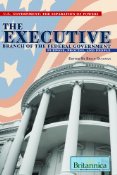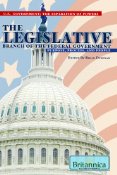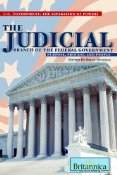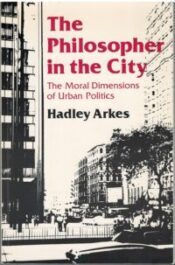
Separation of Powers by Britannica and Rosen Educational Services
As I began the three-book Separation of Powers series published by Britannica and Rosen Educational Services, I anticipated the same excellent quality of their Early American War series (reviewed here). I found a mixed bag.
The Executive Branch
 All three volumes do a credible job of explaining the evolution of each branch of government. The Executive Branch also provides a good description of the various agencies. However, discussions of presidents and vice presidents sometimes display a subtle, but discernible lack of objectivity.
All three volumes do a credible job of explaining the evolution of each branch of government. The Executive Branch also provides a good description of the various agencies. However, discussions of presidents and vice presidents sometimes display a subtle, but discernible lack of objectivity.
For example, historians are usually circumspect when writing about current or recent events, especially those involving on-going controversies. That caution is lacking in this citation from page 18: “The Bush administration also sanctioned the torture of captured enemy combatants to extract information regarding potential terrorist attack—a violation of international law.â€
Use of the term torture is taking sides. A more objective description would have read: The Bush administration sanctioned the use of harsh interrogation techniques to extract information regarding potential terrorist attacks. Critics of the administration called the techniques torture and cited violations of international law.
The section on Vice President Dick Cheney includes the following: “He played a central, controversial role in conveying intelligence reports that Saddam Hussein of Iraq had developed weapons of mass destruction in violation of resolutions passed by the United Nations—reports used by the Bush administration to initiate the Iraq War.“ The implication is that Cheney somehow pressured Bush by presenting tainted reports. In fact, the president was acting on intelligence assessments that, although later disputed, made sense in the post 9/11 climate   and Hussein’s record.
British Prime Minister Tony Blair summed up the thinking of the time in a March of 2002 press conference.   “Let’s be under no doubt whatsoever, Saddam Hussein has acquired weapons of mass destruction over a long period of time. He’s the only leader in the world that’s actually used chemical weapons against his own people. He is in breach of at least nine UN Security Council resolutions about weapons of mass destruction.â€
Whether going to war was the correct decision is very debatable, but textbook writers should avoid the talking points put forth by an administration’s political adversaries.
Woodrow Wilson, readers are informed on Page 225, “is best remembered for his legislative accomplishments and high-minded idealism.†The rest of the description of Wilson’s presidency follows that laudatory lead. However, Wilson’s “idealism†did not include agreement with Constitutional limits on government, a position he made clear in his many writings and attempted to put into practice during his time in the Oval Office. Wilson grew the government at an unprecedented rate; he initiated the income and inheritance taxes and, partly due to the war, increased the national debt dramatically. A more balanced account would have included that information as well as Wilson’s racial segregation of the federal workforce, an especially repugnant policy, (especially for an idealist!) even for the time.
The section on Warren Harding opens with the statement (page 230) that  scandals soon after his death “doomed his presidency to be judged one of the worst in American history.†It concludes (page 233): “By the mid-1920s, the public began to regard Harding as a man who simply did not measure up to the responsibilities of high office.â€
When Harding took office he had to deal with a nation in recession and deeply in debt. During his term he balanced the federal budget, reduced the debt, reformed the budget process and made significant changes in the tax system. That information should have been included along with the scandals.
The account of the New Deal is also skewed, (page 247). “By 1937 the economy had recovered substantially, and Roosevelt, seeing an opportunity to return to a balanced budget, drastically curtailed government spending. The result was a sharp recession, during which the economy plummeted toward 1932 levels. Chastened by the recession, Roosevelt now began to pay attention to advisors who counseled deficit spending as the best way to counter the depression.†This description of events is questionable as is the apparent endorsement of Keynesian economics.
Bias is mostly subtle, but in the case of President Obama, it is funny. In his sanitized hagiography we learn: “Obama experienced great intellectual growth during college and for a couple of years thereafter. He led a rather ascetic life and read works of literature and philosophy by William Shakespeare, Frederick Nietzsche, Toni Morrison and others.†Admiration for President Obama permeates his profile.
The Legislative Branch
 In addition to the historical background of The Legislative Branch, this book includes an informative section on the development of the Library of Congress.
In addition to the historical background of The Legislative Branch, this book includes an informative section on the development of the Library of Congress.
The inclusion of a special “Focus†on the House Un-American Activities Committee, the only House committee to be so honored, seems out of place. The text explains the controversial nature of the Committee and that it was accused of violating First Amendment rights. It also notes that its most high profile proceeding was the investigation of Alger Hiss, accused of involvement in a Soviet espionage ring. All of that is accurate as far as it goes. However, a more balanced account would include the information that whatever the committee’s other failings, the charges against Hiss were accurate and substantiated by the later release of Soviet documents detailing a spy network within the US in general and identifying Alger Hiss in particular.
The introduction to “Select Current and Recent Members†and “Select Past Members†state that those chosen for profiles “are truly remarkable.†Yet, some choices and omissions fall short of that criterion. For example, students will read about Frederick Theodore Frelinghuysen, US senator from New Jersey, (later appointed Secretary of State by President Chester A. Arthur). However, they will not learn about Lucius Quintus Cincinnatus Lamar, one of only eight leaders featured in John F. Kennedy’s book, Profiles in Courage, along with John Quincy Adams and Daniel Webster. Lamar was the first former Confederate official allowed back in the U.S. House of 
Representatives after the Civil War. He was instrumental in crafting the compromise of 1877 that seated Rutherford Hayes as President. He was a patriot and a remarkable individual who fought against the injustices of Reconstruction.
The Reconstruction period receives little attention, except for an account of the Force Acts of 1871-1875 (listed in the back of the book along with other “Historic Laws and Resolutionsâ€) The term does not even appear in the Glossary in the back of the book.
Some descriptions of members of Congress are selectively sanitized. Robert Byrd, for example, is described as having brought “industry and federal jobs to West Virginia through his position as chairman of the Senate Appropriations committee.†That is true as far as it goes. It is a nice stand in for his record as king of the pork barrel politicians – some $3.3 billion during his career. In addition to explaining the meaning of the sanitized sentence, such information adds color and interest for young readers.
John Kerry gets a similarly sanitized profile. There is no mention of the dispute over his alleged exaggerations of his Viet Nam service or his unsubstantiated allegations that US soldiers regularly engaged in mass murder of civilians, although his anti-war testimony before Congress is noted.
Strom Thurmond and Robert Byrd are both identified as having been Southern segregationists. However, the Thurmond article concludes with the following: “Soon after Thurmond’s death it was revealed that at the age of 22 he had fathered a daughter out of wedlock. The mother was a 16-year-old African American maid who worked for his family.†One wonders why the authors thought Thurmond’s  behavior as a 22-year-old is relevant.
The Judicial Branch
 This is the best volume in the set. The explanation of The Judicial Branch and landmark decisions are well done if sometimes incomplete. More attention might have been devoted to the First Amendment prohibition of government establishment of religion and later Court rulings barring public religious practice (prayer in school, creches on public land, etc). Similarly, the conflict between decisions upholding affirmative action and the Equal Protection Clause of the 14th Amendment might have been explored.
This is the best volume in the set. The explanation of The Judicial Branch and landmark decisions are well done if sometimes incomplete. More attention might have been devoted to the First Amendment prohibition of government establishment of religion and later Court rulings barring public religious practice (prayer in school, creches on public land, etc). Similarly, the conflict between decisions upholding affirmative action and the Equal Protection Clause of the 14th Amendment might have been explored.
However, I take issue with the use of the term “living constitution†to explain the general principles that have kept the Constitution relevant over the centuries. Unfortunately, that term describes a concerted political effort to make fundamental changes to the document.
The treatment of individual jurists is not always even handed. For example, by the writing of this book, Clarence Thomas’ record as a thoughtful jurist was well established.
Yet, although his profile references the shamefully acrimonious confirmation hearings and allegations of sexual harassment by Anita Hill, his identification as a “conservative†does not include an explanation of that judicial philosophy.
Given the division between conservative and liberal members of the Court, both terms ought to be defined.
These books are written for 9-12th grade students whom, it must be assumed, lack contextual knowledge of people and most historical events. That being the case, textbook writers have to work really hard to avoid simply regurgitating popular conceptions (or misconceptions) of an era. That often requires a more thoughtful and nuanced approach. On balance, the authors handled complex issues as well as can be expected for a book of this kind.
 The posts are coming!
The posts are coming!

0 comments
Kick things off by filling out the form below.
Leave a Comment